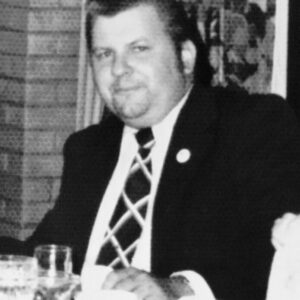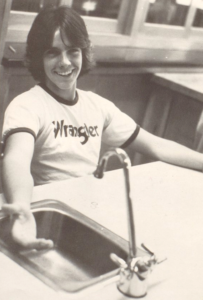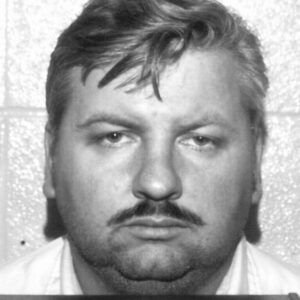John Wayne Gacy, one of America’s most infamous serial killers, murdered 33 young men between 1972 and 1978.
By day, he was the beloved “Pogo the Clown,” entertaining kids at parties and hospitals. But behind the mask, he was a ruthless predator.
His last words after sitting on death row for 14 years would also become infamous.
Who was John Wayne Gacy?
John Wayne Gacy, one of America’s most infamous serial killers, led a chilling double life.
By day, he was the neighborhood’s beloved “Pogo the Clown,” entertaining children at parties and performing at charity events. By night, he prowled the streets of Chicago, hunting young men to abduct, assault, and murder. Between 1972 and 1978, Gacy claimed the lives of at least 33 victims, many of them teenage boys.
A sickly and overweight child
John Wayne Gacy was born on March 17, 1942, in Chicago, Illinois, the only son in a Catholic family of Polish and Danish descent. He was close to his mother and sisters but endured a troubled, often abusive relationship with his alcoholic father, who belittled him and punished him harshly — even for minor mistakes.
Gacy grew up under the shadow of his abusive father, who constantly called him a “sissy” and a “mama’s boy.”

Like many kids, Gacy dreamed of becoming a police officer as he grew up.
Growing up, Gacy longed for his father’s approval but always felt he came up short, shaping a fractured childhood that foreshadowed his dark future. Early trauma included physical beatings and sexual abuse by a family friend, experiences Gacy kept secret out of fear.
Working as a mortuary attendant
At eleven, a swing struck him in the head, triggering recurring blackouts that weren’t fully understood until he was sixteen, when doctors discovered blood clots in his brain and treated him immediately.
Struggling in school, he dropped out of four different high schools. In 1962, Gacy left home and moved to Las Vegas.
In Las Vegas, Gacy started working as a mortuary attendant and later managing a shoe company and several KFC locations. He married Marlynn Myers in 1964, and the couple had two children. Then, his life took a dark turn in 1968 when he was convicted of sexually assaulting a 15-year-old boy, receiving a ten-year sentence but serving just 18 months.
His first known murder came in 1972, when he killed Timothy McCoy and buried him beneath his house. Over the next seven years, Gacy would go on to kill at least 32 more young men.
A monster behind the mask
Sadly Gacy’s horrific crimes went unnoticed for years.
He often lured victims with promises of work or favors, often pretending to be a police officer. Some survived his brutal attacks, but most were strangled and buried beneath his suburban home.
Despite repeated encounters with law enforcement, his carefully constructed persona allowed him to evade capture for years.
Everything changed in December 1978, when 15-year-old Robert Piest disappeared.
Murder of Robert Piest
Robert Piest worked evening shifts at the Nisson Pharmacy in Des Plaines, a suburb of Chicago, and his mother, Elizabeth, usually picked him up at 9 p.m. One night, as she arrived, Robert asked her to wait, saying he needed a moment to speak with ”some contractor” about a summer job.
Twenty minutes passed, and when he didn’t return, Elizabeth went inside to look —but Robert had disappeared.

Worried, she called one of the pharmacy owners. He confirmed that earlier that day, a contractor named John Gacy had visited, offering summer work to local high school boys. The pharmacy owner thought Robert might have gone with Gacy, but when he tried calling, Gacy didn’t answer.
Hours later, Robert’s parents called the police.
Detectives pulled Gacy’s criminal record and discovered that in 1968 he had been sentenced to ten years in Iowa for sodomy, though he served only two. The details of the crime weren’t specified, but the revelation immediately set off red flags.
Gacy’s confession
During house searches and interrogations, law enforcement discovered Gacy’s hidden crawlspace filled with bodies and evidence of his grotesque crimes.
Gacy confessed to killing dozens of young men, explaining his dual personalities: the friendly clown “Pogo” and the sinister “Jack,” who carried out the murders. Using a map he sketched for investigators, Gacy led police to 27 of his victims, all discovered hidden in the crawl space beneath his suburban Chicago ranch-style home.
He revealed the full extent of his crimes only after meeting with his attorneys, realizing there was no escaping justice.

In a rambling tirade lasting hours, Gacy admitted he had ”been the judge … jury and executioner of many, many people,” and now wanted to be the same for himself. He claimed to have murdered ”at least thirty” victims, most buried in his crawl space, with five others dumped in the Des Plaines River.
Dismissing his victims as ”male prostitutes,” ”hustlers,” and ”liars,” he shockingly added that he sometimes awoke to find “dead, strangled kids” with their hands cuffed behind their back, believing their bodies were his property.
Gacy’s chilling question
In 1980, John Wayne Gacy was convicted and handed a death sentence.
Reflecting on the verdict in Netflix’s Conversations with a Killer: The John Wayne Gacy Tapes, he chillingly questioned, ”How can you feel relief about something you still don’t understand?”
He went on to dismiss any sense of responsibility, saying, ”Because they say I’m guilty, I’m supposed to feel guilty now? I don’t. I have no remorse.”
Truth about Killer Clown
Gacy spent 14 years on death row, where he became obsessed with painting, creating more than 2,000 works of art — many depicting himself as Pogo the Clown.
Gacy had joined a local clown group back in 1975 and it was then he created his two personas: “Pogo the Clown” and “Patches the Clown,” complete with his own makeup and costumes. He called Pogo the “happy clown” and Patches a “more serious” version. While he didn’t make much money from performing, Gacy later said being a clown let him “regress into childhood.”

During over a decade on death row, Gacy retracted his confession, admitting to only one murder. He penned lengthy letters claiming his conviction was part of a political conspiracy, and a series of appeals delayed his execution for 14 years.
Gacy was the first person in Illinois to be executed against his will since 1962. His lawyers fought fiercely to stop it, arguing that lethal injection was a Nazi invention that would effectively torture him to death.
The state, however, moved forward with the execution.
Error during the execution
On the day John Wayne Gacy was set to be executed, around 1,000 people gathered in Chicago’s City Hall courtyard, according to the Los Angeles Times.
The crowd released balloons and held up signs mocking Gacy’s infamous clown persona.
Footage in Netflix’s Conversations with a Killer captured chants of “Death to Gacy,” with many attendees expressing that while justice was finally being served, his execution should have happened years earlier.
One of Gacy’s survivors, Steve Nemmers, shared his feelings bluntly: “I had no sympathy for him. I had nothing for him.” Meanwhile, jury foreman Ron Beaver described a sense of closure: “The relief came simply knowing that there would be no other children that John Wayne Gacy would kill.”
Given three chemicals
On May 10, 1994, John Wayne Gacy was executed by lethal injection at Stateville Correctional Center.
According to ABC News, Gacy was given three chemicals — one to knock him out, one to stop his breathing, and one to stop his heart. However, a clog in the line prevented the second drug from fully entering at first, prolonging the execution. It took 18 minutes for him to die, roughly four times longer than expected.
John Wayne Gacy last meal
For his last meal, Gacy requested a bucket of KFC, french fries, a dozen fried shrimp, fresh strawberries, and a Diet Coke. That evening, he received last rites from a Catholic priest before being escorted to the Stateville execution chamber.
As a corrections department spokesman, Nio Howell, recounted to the AP, Howell walked through the prison yard with Gacy, who reflected on his life while seated in the death chamber.
Did he apologize for anything?
”Not a thing,” Howell said.
John Wayne Gacy last words
Just before his execution, John Wayne Gacy reportedly delivered his infamous final words: “Kiss my a–.” Prosecutor William Kunkle later clarified in 2020 that Gacy directed this remark to a prison official and it wasn’t part of any formal statement.
According to other reports, Gacy’s final words were these:
“Killing me won’t make anything right. The state is killing me.”
Killer Clown new series
John Wayne Gacy’s shocking spree — claiming more lives than any other U.S. killer of his era — made him a household name and the focus of countless documentaries, films, and podcasts that continue to fascinate audiences today.

Beyond Netflix’s Conversations with a Killer: The John Wayne Gacy Tapes, Gacy’s horrifying story has been revisited in multiple other documentaries. One notable example is Peacock’s six-part series John Wayne Gacy: Devil in Disguise, which premiered in 2021.
In June 2024, Deadline reported that Peacock had also greenlit a limited drama series based on the same case, with Severance actor Michael Chernus cast to portray Gacy.
All eight episodes of Devil in Disguise: John Wayne Gacy are set to stream on Peacock starting Thursday, October 16.





